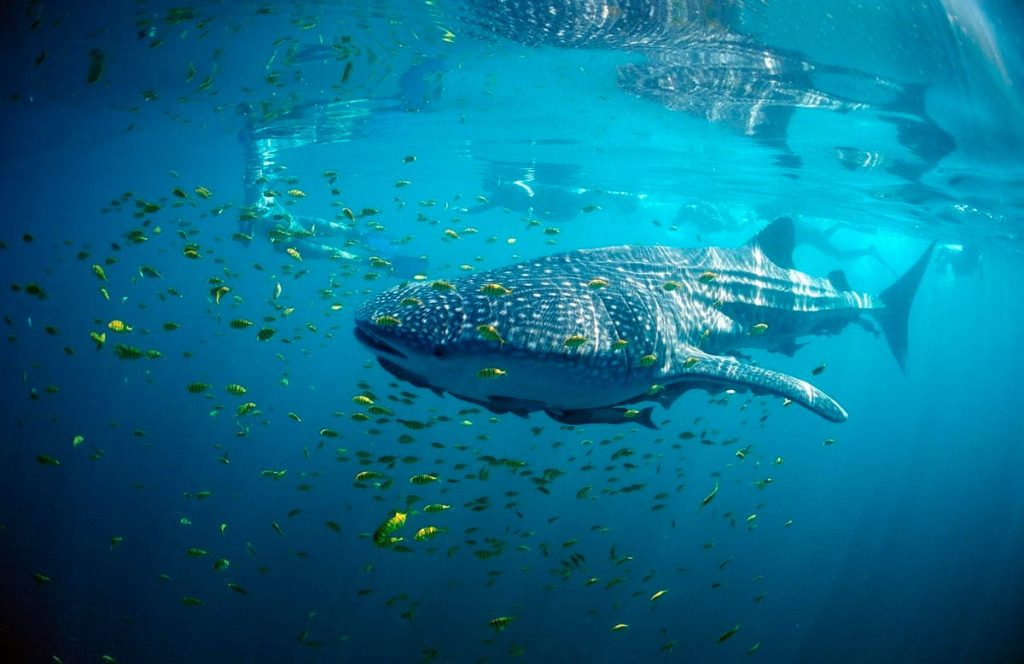In the crystal-clear waters off Western Australia’s Ningaloo Reef, a group of snorkelers huddle together in eager anticipation. Sunlight dances on the surface, casting mesmerizing patterns on the sandy seabed below. The ocean, stretching out in every direction, seemed infinite in its shades of blue. As they bob gently on the surface, snorkels in mouths and fins on feet, their excitement was catching. They had heard whispers of a magnificent visitor – a gentle giant cloaked in stars – heading their way. All eyes were fixed on the horizon, scanning for the telltale signs.
And then, a fin sliced through the water’s surface.
Below, a colossal silhouette emerges from the blue, slowly taking shape as it grows closer. A whale shark (Rhincodon typus) slowly swims past them, seeming to stretch endlessly, dwarfing everything in its path. A swirling vortex of life surrounds it, thousands of fish creating a shimmering halo around the filter feeder. There exists an unexpected companionship between whale sharks and a motley crew of fellow aquatic travelers. Among these companions are remoras, cobia, and schools of baitfish, forming a unique assemblage that has now piqued the curiosity of marine scientists and enthusiasts alike. While their association with remoras has been widely recognized as symbiotic, with remoras hitching rides and providing a valuable service by dining on parasitic copepods, the purpose of baitfish and cobia in this underwater alliance has remained somewhat enigmatic.
To decipher the intricacies of this aquatic entourage, scientists have put forth several hypotheses. One theory proposes that whale sharks serve as protectors, offering shelter from larger predators to their smaller companions. The colossal presence of a whale shark can be a formidable deterrent against potential threats, allowing the smaller fish to navigate the seas with a reduced risk of becoming a meal. Others believe that the pressure waves generated by the swimming sharks might bestow an unexpected boon upon the baitfish. This hydrodynamic phenomenon could potentially lessen the energy expenditure required for baitfish to traverse the water, offering them a unique advantage in their oceanic journeys. Yet another hypothesis suggests that the presence of whale sharks may inadvertently lead the way to bountiful feeding grounds. As the whale sharks forage for sustenance, they may unwittingly guide their companions to a veritable buffet of delectable prey.
So, which is it?
Recent observations by Western Australian researchers have unveiled adult trevally, a type of carangid baitfish, engaging in dynamic feeding frenzies amidst schools of baitfish associated with whale sharks. Camera tags affixed to the whale sharks captured riveting footage of trevally launching swift attacks around the sharks, voraciously devouring their prey in mere seconds. In response to this intense activity, the whale sharks temporarily altered their swimming behavior, adopting a tail-down, vertical posture. Once the feeding frenzy subsided, the remaining baitfish congregated around the head of the whale shark, where they, too, met their fate. Oops.
These dramatic encounters were not limited to scientific observations alone. A tourism photographer in Ningaloo Reef, Australia, captured similar scenes, further illuminating the relentless predation of trevally on the baitfish schools. To quantify the frequency of such predation events, researchers meticulously analyzed video footage from camera tags deployed on multiple whale sharks at Ningaloo Reef. Their analysis uncovered a remarkable revelation: an astonishing 0.65 predation events occurred per hour, with these frenetic attacks typically lasting a brief 7 seconds. Interestingly, the events witnessed during the scientific observations involved a smaller number of trevally compared to what had been observed in similar situations that were recorded by tourism operators. This suggests that this behavior may display some degree of variability or unpredictability, with different circumstances influencing the level of trevally involvement in the predatory events.
Intriguingly, the high incidence of trevally attacks on baitfish challenges the conventional wisdom that shelter from predators serves as the primary incentive for this relationship. Instead, scientists from Murdoch University, the Australian Institute of Marine Science, The University of Western Australia, Texas A&M University, and The University of Texas Marine Science Institute propose an alternative narrative—one that emphasizes the energy-efficient advantages bestowed upon baitfish. “Rather than reducing predation, this association may provide energetic and food acquisition advantages for baitfishes,” the authors explain. “Whale sharks at Ningaloo Reef (and other aggregation sites) move throughout the region to locate dense prey patches with high energetic value where accompanying baitfish riding the bow wave gain the advantage of moving through the water column for a lower energetic cost. Furthermore, these baitfish are capable of exploiting the same food resources located by the whale sharks, with negligible impacts on the food available to the sharks, potentially leading to a commensal relationship that is energetically beneficial to the baitfishes.”
Read the full article here










